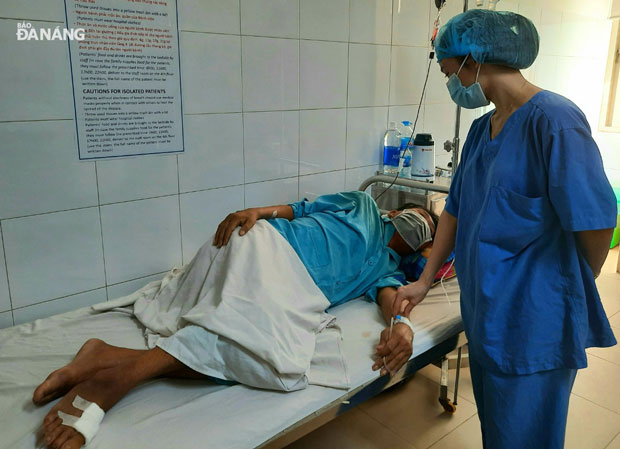Public warnings against Whitmore's disease rise in Central Viet Nam following historic deluges
A streak of extreme flooding starting from October has given rise to Whitmore’s disease, also known as Melioidosis, in hard-hit Central Viet Nam. In October and November, 28 Whitmore’s disease-stricken people, the majority of whom hail from such floods-plagued central localities as Quang Nam, Quang Ngai, Nghe An and Da Nang, were admitted to the Da Nang General Hospital, one of the largest of its kind in Central Viet Nam, for treatment.
 |
| A Whitmore’s disease-stricken being treated at the Da Nang General Hospital |
According to briefings on the disease by doctor Pham Ngoc Ham, Head of the Department of Tropical Medicine at the hospital, Whitmore's disease is an infectious and fatal disease caused by a bacterium called Burkholderia pseudomallei.
The bacteria are found in contaminated water and soil, and it can be spread to humans and animals through direct contact with sources of contamination. At the site of entry they cause pustules that grow depending on the degree of the case, sometimes a large abscess will develop.
Melioidosis infection commonly involves the lungs, causing pneumonia, abscesses, high fever, night sweats, weight loss, bloody sputum, and pus or blood in the lung tissue, the inflammation of the brain and joints. The associated mortality rate is around 40 percent.
The incubation period is usually 1-21 days. Of special note, people with diabetes, chronic lung disease, chronic kidney disease, and cancer have a higher risk of dying when infected.
More recently, the Ministry of Health has asked health departments of all Vietnamese localities to take proactive measures to prevent Whitmore’s disease. The move was made following recent increase in the number of Whitmore’s disease-catching patients in central Viet Nam, and worse still, four people were declared dead from the ailment in the central province of Quang Tri.
According to the ministry, the disease is rare and does not lead to a pandemic but it can cause septic shock leading to failure of major organs and in some cases, death, particularly among vulnerable groups.
Health authorities across Viet Nam must take samples of suspected cases or those at high risks of infecting with the disease for testing to have proper treatment. Also, raising public awareness of preventive measures against the disease must be a need.
In face of no vaccine for the concerning disease till date, people are advised to keep up personal hygiene and regularly wash their hands with soap and clean water; eat cooked food; and do not eat sick poultry or animals. Besides, they are recommended to limit exposure to sources of pollution, wear shoes, sandals and gloves when in contact with soil, dirty water or flood water. If any open wounds or sores are detected, it is necessary to avoid contact with heavily polluted soil or flood water.
Also, those with chronic diseases such as diabetes and immunodeficiency need care and protection from damage to prevent infections caused by flood water.
First spotted in Viet Nam in the 1950s, the disease is a rare dangerous infectious disease in the country as few cases were detected over the past decades. Its outbreak usually occurs in the rain season, especially from July to November.
Melioidosis is predominately a disease of tropical climates, especially in Southeast Asia and northern Australia where it is widespread. Around 10,000 cases are reported worldwide each year, mostly during the rainy season, around half of which prove fatal.
By PHAN CHUNG- Translated by A.T